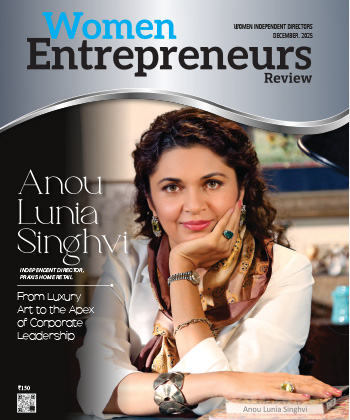
Engaging Gen Z: The Shift from Traditional Marketing to Community-Driven, Tech-Savvy Strategies
By: Priyanka Bhargav, Senior Director, Flipkart
Priyanka Bhargav is a seasoned business leader with over 19 years of expertise in Brand Strategy, Corporate Communications, PR, and Customer Experience. Recognized globally, she has been instrumental in driving customer centricity at Flipkart and has received multiple awards for her leadership and impactful campaigns.
In a conversation with Women Entrepreneurs Review, Priyanka shares her insights on the evolving e-commerce landscape, highlighting the growing influence of Gen Z consumers. She emphasizes the importance of integrating sustainability and ethical practices into brand strategies and discussed futuristic trends and technologies that will shape the industry over the next five years.
How do you perceive the current e-commerce landscape, especially with the rising influence of Gen Z consumers? What trends do you foresee shaping the next five years?
Out of India's 1.4 billion populations, 233 million Gen Z individuals reside in urban areas. This digitally native group is at the forefront of e-commerce and social media adoption. Six out of every ten Gen Z members are e-commerce shoppers, with approximately 156 million on Instagram, 45 million on Pinterest, 120 million on Snapchat, 40 million on Discord, and around 230 million on Facebook. E-commerce companies & Online shopping portals are transforming the shopping experience for Gen Z by incorporating features like communities, channels, updates, catalogs, instant purchases, social validation, and advanced technologies like skin analyser, size recommendations, AR and VR basically shifting towards immersive shopping experiences.
Gen Z, aged 10-24 years, has been raised during a period marked by global upheavals such as terrorism, wars, the COVID-19 pandemic, and climate change, all of which have had a significant impact on them. They have witnessed the rapid growth of technology and the profound influence of social media, including challenges like bullying and trolling. This generation values the balance between conflicting traits, prioritizes self-care, and places great importance on emotional, mental, and physical well-being. For them, a sense of community and belonging is just as vital as their individualism.
85% of the shopping decisions made at home are influenced directly or indirectly by GenZ and as this cohort is entering the workforce they are already shaping the consumption pattern and trends in retail expenditure.
Given the unique behavioral traits and preferences of Gen Z, what innovative strategies can brands adopt to effectively engage this demographic without relying heavily on traditional marketing methods?
They are moving from old social constructs of stability and security to seeking a life that allows space for varied experiences, space for individual expression and freedom from set standards.
Gen Z is more influenced by a community-first approach than a sales-first strategy. They take pride in their collective identity; they prioritize emotional connections and a sense of belonging over purely transactional or sales-driven communication. Engaging Gen Z requires using diverse formats like video commerce, live streaming, and group buying, which not only help them make informed choices but also provide opportunities for social validation. Gamification is another effective way to capture their interest.
When it comes to identifying new trends, Gen Z heavily relies on regional and tech influencers for their perspectives. They are experimentative and adopt and junk trends faster than any other cohort. Additionally, 70% of Gen Z strongly believes in the value of a side hustle. Brands that create opportunities for Gen Z to pursue these side ventures are likely to see strong adoption among this group. This generation is more financially prudent and literate than any other previous generations, and look for guidance and newer trends in the financial markets.
With Gen Z being more conscious about sustainability and ethical practices, how should e- commerce brands integrate these values into their core strategies to attract and retain this Demographic?
Many Indian brands are at the forefront of integrating Ayurveda, traditional remedies (gharelu nuskhe), and Indian Vedic sciences into their product offerings, particularly in fashion, beauty, personal care, and baby care. Gen Z takes immense pride in their Indian heritage, embracing Indian aesthetics, inclusivity in tone, appearance, and body shape, as well as celebrating local flavors, fusion styles, colors, and traditional attire. For brands, the focus should shift from altering to enhancing—Gen Z values the natural accentuation of their looks rather than alteration.
While sustainability in packaging and clothing has been a long-standing trend, it has not yet been widely adopted by brands due to cost pressures. However, Gen Z places high value on authenticity and transparency in brand messaging, a preference that has only grown stronger post-COVID.
Additionally, 77% of Gen Z prefers to shop from brands they follow on social media. They are drawn to brands that are inclusive and have a clear point of view. Personalization is another key trend, with a noticeable shift from B2C (Business-to-Consumer) to B2Me (Business-to-Me) experiences.
How can e-Commerce brands create a seamless omnichannel experience that meets the expectations of Gen Z, who are accustomed to a highly interconnected digital and physical shopping experience?
70% of the GenZ is now browsing for new styles, trends and technologies on the apps, social media hence its important for the brands to create a hyper connected flow to give a seamless experience to this new set of consumers. This also helps the customer build a perception that the brands/ app is intuitive and understands the need states and gaps of the customers. Both explicit and implicit personalisation, profile creation can really help better cater to the customer needs.
With the rise of short-form content and influencer marketing, what are some unconventional tactics that brands can use to capture the attention of Gen Z, and how can they measure the impact of these strategies?
In particular, reaching the Gen Z audience requires brands to go beyond conventional strategies and incorporate such concepts as short videos and creator collaborations. The next generation, the Gen Z needs to be approached in a very unique manner, mostly through the help of dance challenges on TikTok or Instagram Reels. In order to determine the effectiveness of such tactics, it’s important to track engagement indicators, including likes, shares, and comments, to evaluate the relevance of the content. Other parameters that can be measured include the ability to track the number of visits made before converting into a sale as this can tell one how effective the content is in making a sale. Through these key performance indicators the brands can fine-tune their strategies with a view of making them responsive to this tech-savvy generation.
What futuristic trends or technologies do you believe will revolutionize the e-commerce industry, particularly in relation to Gen Z consumers, and how should brands prepare for these changes?
India is on the verge of innovation across multiple areas to reach the next 200 million customers. These include fintech opportunities that enhance affordability, allowing consumers to make informed choices, and Martech advancements for more targeted outreach on and off platforms. Social and video commerce are driving seamless shopping experiences, boosting brand discoverability and trust. Assisted shopping tools are helping customers find the right brands and solutions throughout their journey. AI-driven personalization is being used to provide customized product recommendations, dynamic pricing, and tailored marketing. Additionally, hyperlocal delivery services focus on delivering goods within short time frames, while instant delivery platforms offer essentials and fashion items within minutes, all optimized through AI.
Most Viewed
- 1 Women's Health Startup HerMD Closing Doors Amid Industry Challenges
- 2 5 Famous Women in Indian Armed Forces
- 3 Saudi Women No longer Require Male Permission for Clothing Choices, says Prince MbS
- 4 Kolkata Medtech Startup Innovodigm Raises Rs 5.5 Crore Seed Funding Led by IAN Group
- 5 Yamunanagar's Kashish Kalra Honoured after Securing 111th Rank in UPSC Civil Services Exam
- 6 Madurai Appoints Its First Woman Corporation Head
- 7 IAS Vijayalakshmi Bidari Appointed as the new Nagpur Divisional Commissioner
- 8 American Entrepreneur Lucy Guo Overtakes T Swift to become Youngest Female Billionaire
- 9 ICC Women's World Cup 2025 Trophy Showcased at Indore's Holkar Stadium
- 10 Aparna Saxena's Beauty Venture AntiNorm Launches in India
- 11 Vidya Nataraj Co-Founded BlueStone Jewellery & Lifestyle files IPO
- 12 5 Women Freedom Fighters of India
- 13 Dr. G Krishnapriya appointed as CEO for Trichy
- 14 M3M & Sirona Partner to Introduce Menstrual Hygiene Vending Machines in 15 Locations
- 15 Punjab Govt launches SHE Cohort 3.0 Supporting Tech-led Women Startups
- 16 Indian origin Lawyer, Sweena Pannu appointed as the US New Superior Court Judge
- 17 The Aurora Tech Award recognizes 4 Indian Women-led Startups
- 18 Kerala's Republic Day parade featured an all-female tableau
- 19 Manisha Kabbur Becomes Karnataka's First Woman International Karate Coach
- 20 Director K. S. Ravikumar's Daughter Maalica Ravikumar Launches Life Coaching Company 'Evergrowth Academy' for Women
- 21 Leezu's Raises Pre-Seed Funding to Accelerate Growth in Sexual Wellness Industry
- 22 Sattu: Super-easy summer drink for PCOS gut healing
- 23 Swathi Nelabhatla creates Sitha App, India's First Women-Exclusive Gig Platform
- 24 7 Timeless Female Kathak Dancers & their Iconic Legacies
- 25 Meet 7 Iconic Women Architects of Modern India & their Most Impactful Work
- 26 This Woman-led Insuretech Startup is Helping Bridge the Education Financing Gap in India
- 27 Women Leaders Share Lessons Learnt from India Women's WC Win
- 28 5 Enterprising Women Founders Powering Singapore's Tech & Innovation Landscape
- 29 4 Women. 4 Stories. One Vision for Smarter, Stronger Healthcare
- 30 Global Gender Gap Narrows to 68.8%, But Full Equality 123 Years Away: WEF Report 2025
- 31 Changemakers: 7 Women Entrepreneurs Taking the Make in India Movement Forward
- 32 Meet Lucy Guo, The Youngest Self-Made Female Billionaire Disrupting Tech
- 33 How Women are Driving India's Festive Online Shopping Surge






